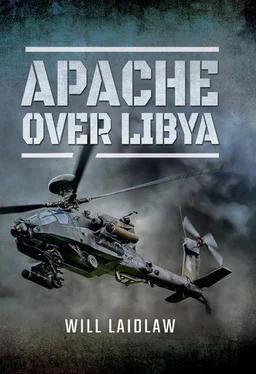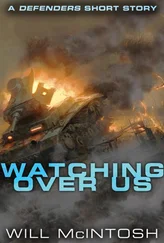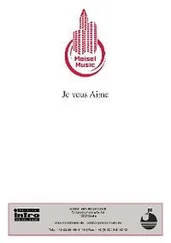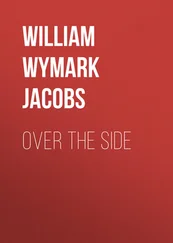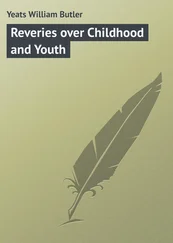Nick, damp through with the sweat of another combat mission and long low-level sea track, could only chuckle and sit down to write the MISREP.
His narrative was the now prescriptive retelling of the facts – heights and speeds, headings and missile launches, coordinates and target effect. Checkpoints and technicals again, but they were significant. If the regime controlled the roads the FLF would be held back. If we knocked the checkpoints out, fear of loitering attack helicopters would encourage more desertions, the roads would be clear and the FLF could move. The no-show from the ZSU 23-4 was good news; being surprised by one of those could have presented a very different outcome. We reviewed the guntape and finished the MISREP.
From an initial five addressees, we now had to send our MISREP to over thirty people, and our Ops team had to work through until breakfast to edit and upload the guntape footage. Every other day a new email would arrive from someone in London demanding to get early sight of the MISREP ‘so I can brief my boss’. I knew that by the time I got to my cabin, tired and grateful that we’d got through another mission without coming unstuck, officers in London would be opening their email, reading the MISREP and viewing the footage.
The scrutiny was intense, much of it necessary and useful. Some of it, however, was just access to information. Occasionally, contextless questions were generated that made our days longer than they needed to be and made me wonder if these people really knew where we were and what we were doing. Ignoring the CAOC, they would reach right into the ship to question us. Bypassing those who knew our work, they made the electronic leap of thousands of miles to ask ‘Why did you fly there?’ or ‘Why did you shoot that?’ Often such missives were double- or triple-sent over a period of hours, if the initial email was not answered immediately. Of course, by the time the London latte had cooled enough to drink and the email was sent, I was asleep in my cabin. The question-generator didn’t know that, and the third email would usually arrive with highlighted demands for his second-guessing by about lunchtime. Which was also, as it happened, the time that I would get out of bed.
Back at the sharp end of the war, the FLF had watched the mission going in. Pro-Gad did desert, and a gaping hole opened just where the regime needed to be strong. Colonel El-Moktar Firnana took his opportunity, and the following day Libyan rebels began to advance north, taking ground previously held by Gaddafi. A tentatively planned Apache strike against more checkpoints was aborted late that night due to uncertainty over who was where on the ground. We chalked up another cancellation, but the irony was that the success of our first strike on the third front was putting us out of business.
Chapter 13
Okba and the 99th Hellfire
With the roads out of the mountains now contested and the utility of the Apache proven, Glen Parker settled on the Okba airfield staging ground for a mission. If Okba was put out of commission the FLF could advance out of the mountains on two or three routes, take the north coast and move on Tripoli. Opening up more than one avenue meant the regime would be spread too thinly to hold back the FLF. With Az-Zawiyah under threat they would probably withdraw to defensive positions around the town. Once that fell, their final option would be to defend the regime in Tripoli itself. NATO now needed to open those routes north and north-east while still attempting to kill the regime from the top down. For our part, we were firmly on the front line creating opportunities for the FLF to advance.
Two days after the first raid we sent another patrol towards the mountains, this time further inland than we had ever gone. The target was Okba airfield and a checkpoint nearby. Although the aircraft and the surface-to-air missile battery that once operated from there had been destroyed, pro-Gad were still using the area as a staging post for soldiers to gather and then set off for the front line. It was their last safe place before meeting the FLF. Our task was to take it from them, removing their safety and destroying as much equipment as possible. If this worked it would create a gap in the front line where no pro-Gad could show up. The FLF could then move forward, the next stop being the coast and then Az-Zawiyah. If we failed, the FLF would have to fight their way up a single road and through the desert to reach the coast. This would cost lives, take weeks and could ultimately be repelled if the regime were clever enough. This was an opportunity, a tipping point, the chance for the FLF to get the momentum they needed to make a rush on Tripoli.
The plan was almost identical to the earlier raid. Nick was the patrol commander. He and Charlie Tollbrooke took the callsign Underdog One. Big Shippers and Jay Lewis, in the wing aircraft, joined them as Underdog Two. But Okba was a long way inland. More time low-level over Libya meant more opportunities for pro-Gad to have a go. We still needed to keep Ocean over the horizon and inconspicuous, so they had to accept the distance and resolve to keep enough ammunition in reserve in case they got into a fight on the return leg. The long transit also meant that there was little time on target. This, in turn, meant that decisions to shoot and re-engage would have to be quick and precise. We considered whether fitting additional fuel tanks would be useful but rejected the idea once Little Shippers calculated the extra weight this added. Extra weight meant less Hellfire. Less Hellfire was the wrong answer.
The CAOC said it was a ‘Go’ even without a Pred on the mission. We had fast jets with Litening Pods and laser-guided missiles able to dash between Tripoli and us in a matter of minutes. If we got into trouble they were to lend a hand, and if we needed to find a tricky target they might look down and guide us on. That was the plan, anyway, and it all looked good on the slide they sent through. But we doubted whether a jet was going to help in a SAMbush; he couldn’t do so unless his pod could see into the future, which, with all the wiggly amps in the world, it couldn’t. Still, we were winning with every mission and this was going to be no different.
Nick briefed his plan. It was simple: arrive, observe, decide shoot or no shoot, move on and repeat at the next target. At the final ‘Go/No Go’ brief the Intelligence Officer told us of an increase in pro-Gad activity on the coast and reinforcements moving south from Zuwara towards the mountains. A column of eight vehicles had been reported in the target area. There might be more targets than we had ammunition for, but it was too late to spin up two more aircraft and make a four-ship; Nick would have to judge his ammunition expenditure.
Again, John and I were in the Ops Room, timeline and map laid out on the desk, JCHAT glowing and the 56 thRescue Squadron hanging around waiting for a shoot-down to dive into. At the given time the aircraft lifted and ducked low into the night. Within a few seconds the howl of their engines had faded and Ocean turned south-west, heading for the recovery point.
The radios and the JCHAT remained silent for the next two hours. Ocean cut a tight circuit at the recovery point and the Ops Room got restless, then anxious. Two hours was just about on the fuel limit; a few more minutes and they would be burning into their minimum fuel for landing.
At the two hour and five minute point the radio burst into Nick’s request to join and land. Wings was up in Flyco with his senior controller. ‘Cleared straight in,’ came the reply. I did a quick fuel calculation in my head: they should be right on their minimum, a minute or two more and we could be listening to an emergency. No need. The aircraft landed in turn, and five minutes later Nick and Big Shippers were in the flip-flop, guntape ready on screens set up side by side.
Читать дальше
